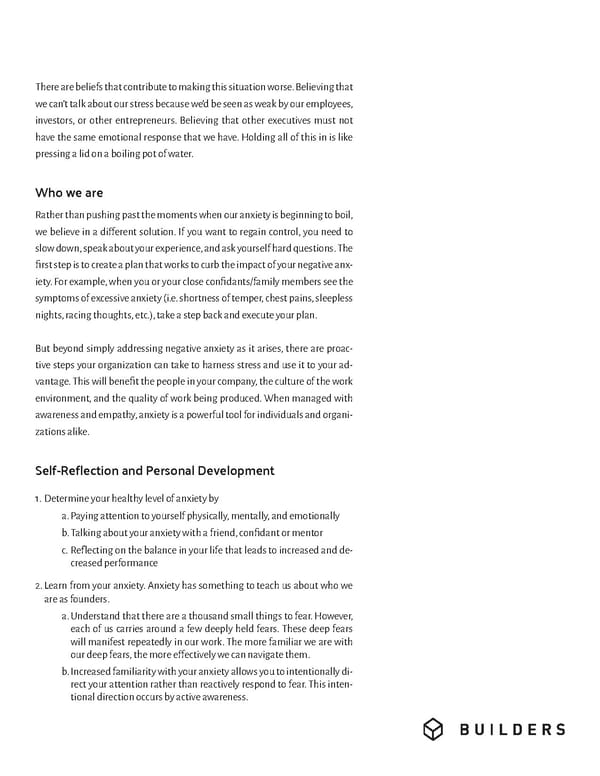There are beliefs that contribute to making this situation worse. Believing that we can’t talk about our stress because we’d be seen as weak by our employees, investors, or other entrepreneurs. Believing that other executives must not have the same emotional response that we have. Holding all of this in is like pressing a lid on a boiling pot of water. Who we are Rather than pushing past the moments when our anxiety is beginning to boil, we believe in a different solution. If you want to regain control, you need to slow down, speak about your experience, and ask yourself hard questions. The first step is to create a plan that works to curb the impact of your negative anx- iety. For example, when you or your close confidants/family members see the symptoms of excessive anxiety (i.e. shortness of temper, chest pains, sleepless nights, racing thoughts, etc.), take a step back and execute your plan. But beyond simply addressing negative anxiety as it arises, there are proac- tive steps your organization can take to harness stress and use it to your ad- vantage. This will benefit the people in your company, the culture of the work environment, and the quality of work being produced. When managed with awareness and empathy, anxiety is a powerful tool for individuals and organi- zations alike. Self-Reflection and Personal Development 1. Determine your healthy level of anxiety by a. Paying attention to yourself physically, mentally, and emotionally b. Talking about your anxiety with a friend, confidant or mentor c. Reflecting on the balance in your life that leads to increased and de- creased performance 2. Learn from your anxiety. Anxiety has something to teach us about who we are as founders. a. Understand that there are a thousand small things to fear. However, each of us carries around a few deeply held fears. These deep fears will manifest repeatedly in our work. The more familiar we are with our deep fears, the more effectively we can navigate them. b. Increased familiarity with your anxiety allows you to intentionally di- rect your attention rather than reactively respond to fear. This inten- tional direction occurs by active awareness.
 Healthy Stress - Unlocking The Power Of Anxiety Page 3 Page 5
Healthy Stress - Unlocking The Power Of Anxiety Page 3 Page 5